Wondering how to change time on Fitbit Charge 2 without app? You’re not alone. This article breaks down the process into easy-to-follow steps, ensuring that you can change the time on your Fitbit Charge 2 effortlessly.
What You Will Need
Before you start, ensure that you have the following:
Your Fitbit Charge 2: Make sure it’s fully charged to avoid any interruptions.
A computer with an internet connection: You’ll need to log into your Fitbit account via a web browser.
This Amazon Eero 6+ mesh Wi-Fi router has fast and reliable gigabit speeds and is able to connect 75+ devices, with a coverage of up to 1,500 sq. ft. Therefore, it can provide you with superb internet connection.
Steps on How to Change Time on Fitbit Charge 2 Without App
The steps below will guide you on how to change time of Fitbit Charge 2 without app:
Step 1: Log Into Fitbit Dashboard
Accessing your Fitbit Dashboard is the first critical step in changing the time settings on your Fitbit Charge 2. This is where all the magic happens. Here’s a detailed breakdown:
Open your preferred web browser on your computer. It could be Chrome, Firefox, Safari, or any other browser you are comfortable with.
Type Fitbit’s official website into the browser’s address bar and hit ‘Enter’.
You’ll see an ‘Accounts’ icon at the top-right corner of the homepage. Click on it.
A new page will open asking for your email and password. These are the credentials you used when setting up your Fitbit account. Enter them and click the ‘Login’ button.
If you’ve forgotten your password, there’s a ‘Forgot password?’ link on the same page. Click on it and follow the instructions to reset your password.
Once logged in, you’ll be taken to your Dashboard, a centralized panel displaying all your fitness data and device settings.
Step 2: Locate Device Settings
Once you’re on the Dashboard, you’ll need to navigate to the device settings. This is where you’ll find the options to adjust the time on your Fitbit Charge 2.
On the Dashboard, you’ll see multiple tabs. One of them is labeled ‘Devices’. Click on it.
You’ll now see a list of Fitbit devices that are connected to your account. Find your Fitbit Charge 2 among them.
Click on the Fitbit Charge 2 icon to open a new page that will display all the settings related to this specific device.
Step 3: Modify Time Zone
After accessing your Fitbit Charge 2 settings, you’ll need to change the time zone. Doing so will automatically adjust the time displayed on your device.
Scroll down the page until you find the section labeled ‘Time Zone’.
Next to ‘Time Zone’, there should be a drop-down menu. Click it to see the available time zones.
Select the correct time zone for your current location from the list.
After making your selection, look for a ‘Save’ or ‘Apply’ button—this may vary based on browser or interface—and click on it to confirm your changes.
Step 4: Sync the Changes
Having adjusted the time zone, your next task is to ensure these changes reflect on your Fitbit Charge 2.
Normally, at the top of the device settings page, you’ll find a ‘Sync Now’ button. This button triggers an immediate synchronization between the website settings and your device.
Click the ‘Sync Now’ button. A progress bar may appear indicating that the sync is in progress.
Wait until the sync is complete. This usually takes a few seconds but could vary based on your internet speed.
Step 5: Confirm the Changes
The final step involves verifying if the time on your Fitbit Charge 2 has been successfully updated.
Check the display screen of your Fitbit Charge 2. You should see the time displayed.
If the time still fails to update, try syncing again. There could have been a delay or some other minor issue affecting the sync.
If all else fails, log out of your Fitbit Dashboard and log back in, then repeat the sync process.

